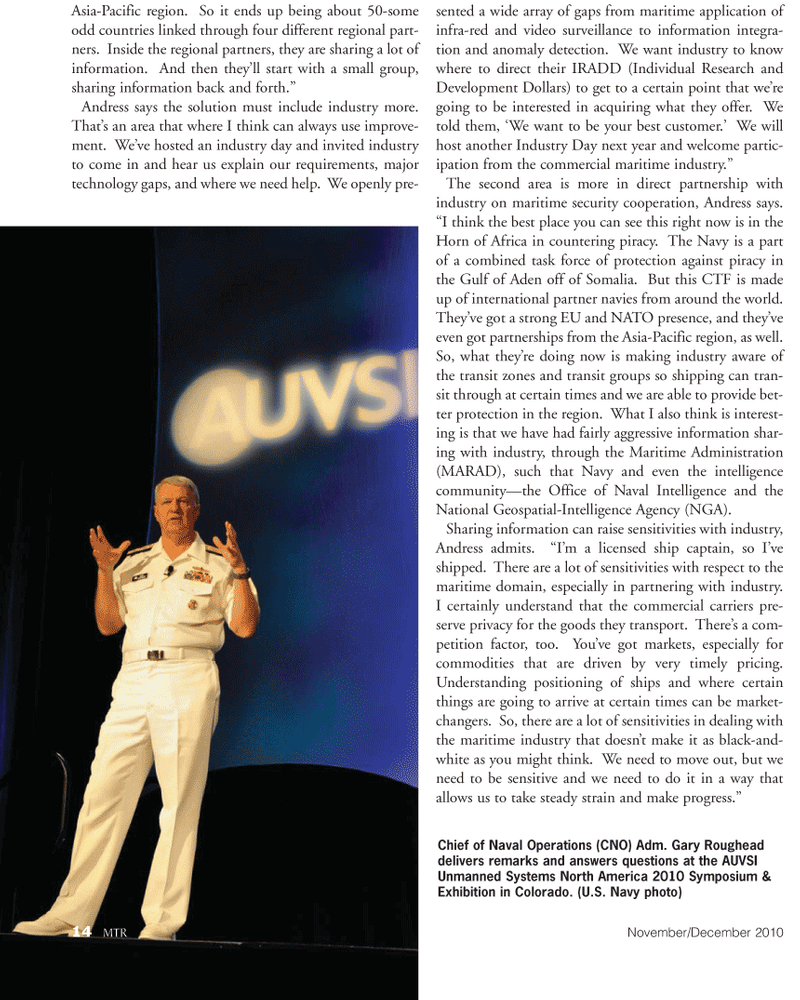
Page 14: of Marine Technology Magazine (November 2010)
Fresh Water Monitoring and Sensors(lakes, rivers, reservoirs)
Read this page in Pdf, Flash or Html5 edition of November 2010 Marine Technology Magazine
Asia-Pacific region. So it ends up being about 50-some odd countries linked through four different regional part- ners. Inside the regional partners, they are sharing a lot of information. And then they’ll start with a small group, sharing information back and forth.”
Andress says the solution must include industry more.
That’s an area that where I think can always use improve- ment. We’ve hosted an industry day and invited industry to come in and hear us explain our requirements, major technology gaps, and where we need help. We openly pre- sented a wide array of gaps from maritime application of infra-red and video surveillance to information integra- tion and anomaly detection. We want industry to know where to direct their IRADD (Individual Research and
Development Dollars) to get to a certain point that we’re going to be interested in acquiring what they offer. We told them, ‘We want to be your best customer.’ We will host another Industry Day next year and welcome partic- ipation from the commercial maritime industry.”
The second area is more in direct partnership with industry on maritime security cooperation, Andress says. “I think the best place you can see this right now is in the
Horn of Africa in countering piracy. The Navy is a part of a combined task force of protection against piracy in the Gulf of Aden off of Somalia. But this CTF is made up of international partner navies from around the world.
They’ve got a strong EU and NATO presence, and they’ve even got partnerships from the Asia-Pacific region, as well.
So, what they’re doing now is making industry aware of the transit zones and transit groups so shipping can tran- sit through at certain times and we are able to provide bet- ter protection in the region. What I also think is interest- ing is that we have had fairly aggressive information shar- ing with industry, through the Maritime Administration (MARAD), such that Navy and even the intelligence community—the Office of Naval Intelligence and the
National Geospatial-Intelligence Agency (NGA).
Sharing information can raise sensitivities with industry,
Andress admits. “I’m a licensed ship captain, so I’ve shipped. There are a lot of sensitivities with respect to the maritime domain, especially in partnering with industry.
I certainly understand that the commercial carriers pre- serve privacy for the goods they transport. There’s a com- petition factor, too. You’ve got markets, especially for commodities that are driven by very timely pricing.
Understanding positioning of ships and where certain things are going to arrive at certain times can be market- changers. So, there are a lot of sensitivities in dealing with the maritime industry that doesn’t make it as black-and- white as you might think. We need to move out, but we need to be sensitive and we need to do it in a way that allows us to take steady strain and make progress.” 14 MTR November/December 2010
Chief of Naval Operations (CNO) Adm. Gary Roughead delivers remarks and answers questions at the AUVSI
Unmanned Systems North America 2010 Symposium &
Exhibition in Colorado. (U.S. Navy photo)

 13
13

 15
15
